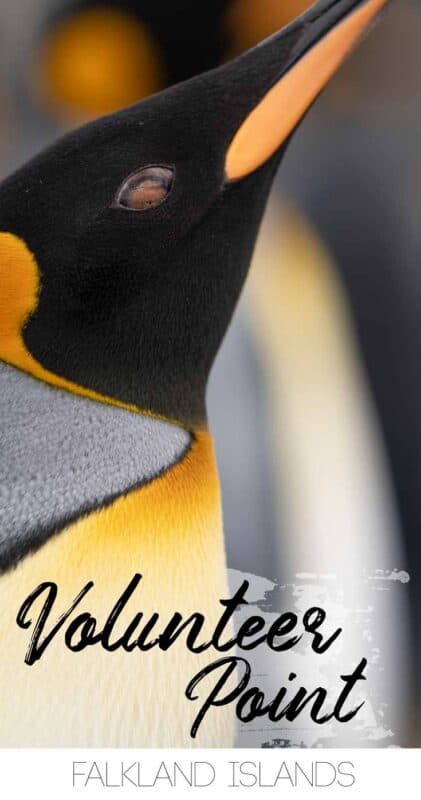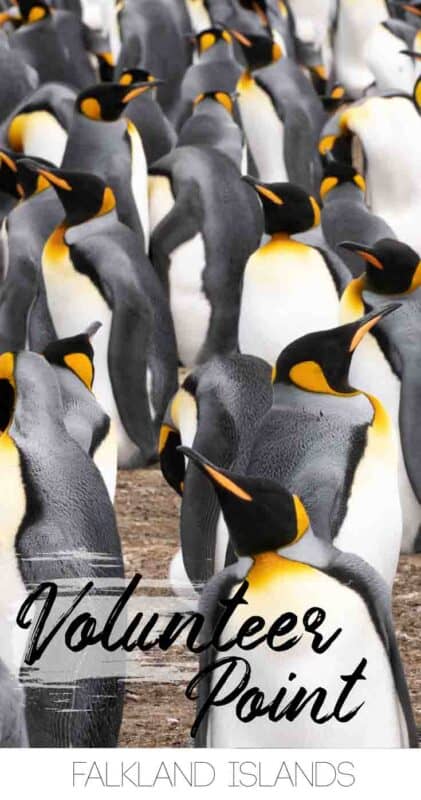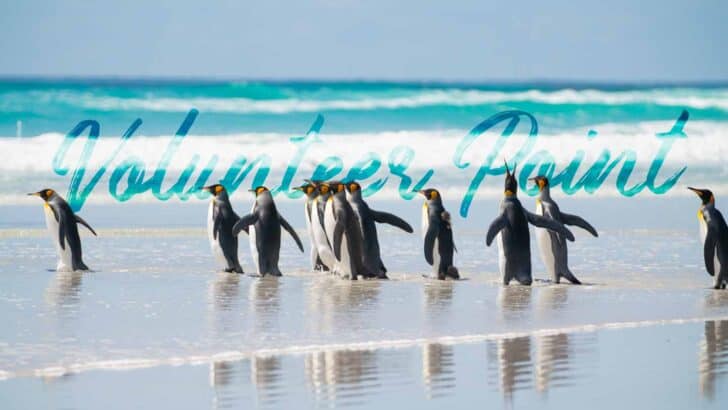Whether you are visiting the Falkland Islands for the day during an Antarctica cruise or exploring by land, a trip to Volunteer Point should be very high on our list of things to do in the Falkland Islands.
This is a very special place and one of the few where you can spot King Penguins in the Falkland Islands. Our day trip out to see the king penguins was a highlight among the highlights of our two week trip to the Falkland Islands.
Volunteer Point Video
Volunteer Point Tours
Volunteer Point is the highlight for those visiting the Falklands on an Antarctica cruise. Tours sell out fast. We recommend booking this tour in advance to secure a spot.
Our Volunteer Point Day Trip
Like most things in life worth doing, getting out to see the King Penguins comes with some work. Trips to Volunteer Point depart from Stanley, and getting there is part of the adventure.
This drive has a bit of a reputation among locals and visitors who have made the journey. The first half an hour starts out pretty innocent, but when the road ends, the real drive begins.
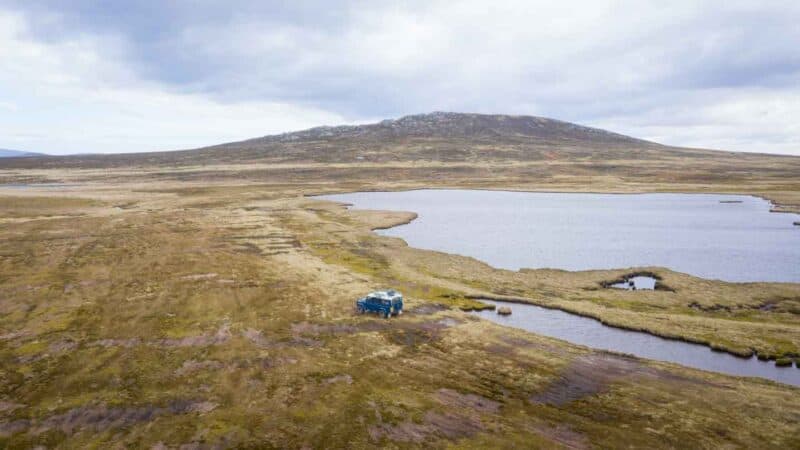
Google Maps shows a thin white line indicating a road to Volunteer Point from Johnson’s Harbor, but that’s not exactly the case. There isn’t a road. There isn’t even really a track to Volunteer Point.
You kind of have to know the way, and you have to risk getting ‘bogged’ as the locals call it while making the 10+ mile voyage across peat bog-filled farm fields to reach the beach.
The King Penguins live on the beach in the far north of East Falkland Island. The current landowners have no intention of cutting a road through the property for fear it would bring too many visitors to the penguins and take away from the adventure.
As challenging as it sounds, the ride is actually a lot of fun. It’s also a chance to talk with locals and learn about what life was like and still is in much of the Falklands.
The sure sign you have made it is the red roof of the warden’s house as you make your way down the final hill that opens up to the ocean. During high season, a warden stays out here full-time to make sure everyone cares for the wildlife. After a quick stop to check in with the warden, the next stop is the penguins.

My first glimpse of the Kings was a small cluster of young adult penguins standing around a perfectly still pond. In the background were a few sheep grazing with their lambs – It doesn’t get too much more “Falkland Islands” than that. If I had to pick just one photo to sum up my trip to the Falklands, this would be one of the top picks.
King Penguins are massive birds standing almost three feet tall (nearly 1 meter) and weighing close to 40 lbs. The adults are regal looking, with golden accents outlining their jet-black faces. The gold color also fringes their bright white chest. The young have a thick brown set of fluffy feathers that look almost like they are wearing a parka.
After a short photo shoot with the penguins near the pond, I was tapped on the shoulder by a fellow photographer I had met a few days earlier on Sea Lion Island. He looked at me with visible excitement in his eyes and said: “We really gotta get down to the beach – there’s no wind right now!”. Now, we haven’t come together to Volunteer Point. We weren’t on the same tour – but he knew I was here for the photos.
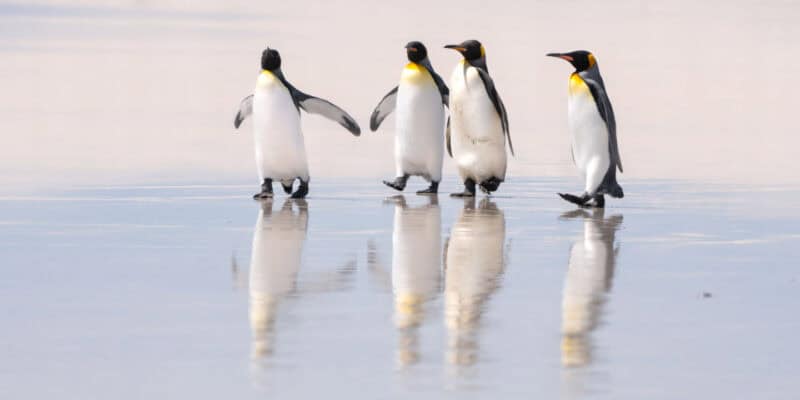
At first, I kind of dismissed the urgency of his suggestion, but it wasn’t until later in the day that I was glad I decided to walk away from what I considered a pretty impressive scene to follow him down to the beach.
After spending the better part of the morning watching the penguins waddle around the white sands, with groups coming and going from the turquoise waters, quickly, the weather began to change.
The calm morning gave way to a sunny but very breezy Falkland’s afternoon. The wind carried sheets of sand across the beach, making it a virtual no-go zone for anyone with a camera in hand. My friend knew that the wind really makes it hard to be on the beach from his last visit and decided to share the tip with me.
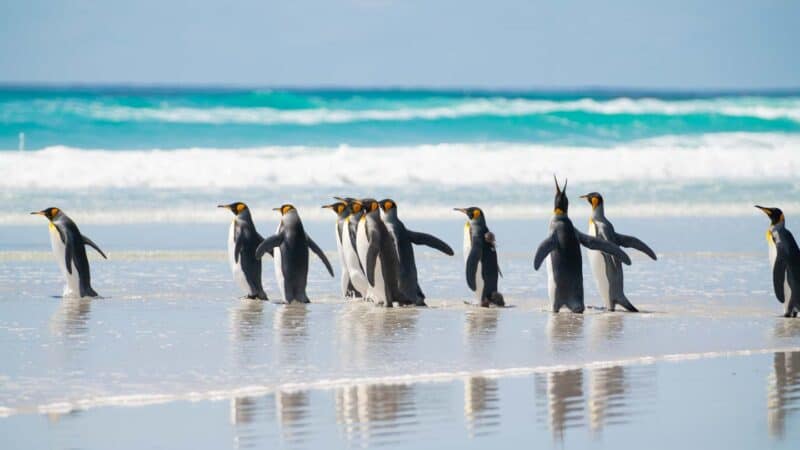
Besides taking away some nice photos from the beach in the morning, it made me realize what a unique place the Falklands are to travel. Where else in the world do fellow travelers that you basically just met encourage you to go to the same places with them to take photos?
I think it speaks to the type of traveler that you meet when visiting the Falkland Islands. Secondly, it’s an indication that there is so much wildlife compared to the number of visitors that people are willing to share. It’s easy to look at the photos of cute penguins, and that is reason enough to visit – but for me, it’s the interactions I had with both locals and visitors that make me want to return to the Falklands.
But the cute penguins though…
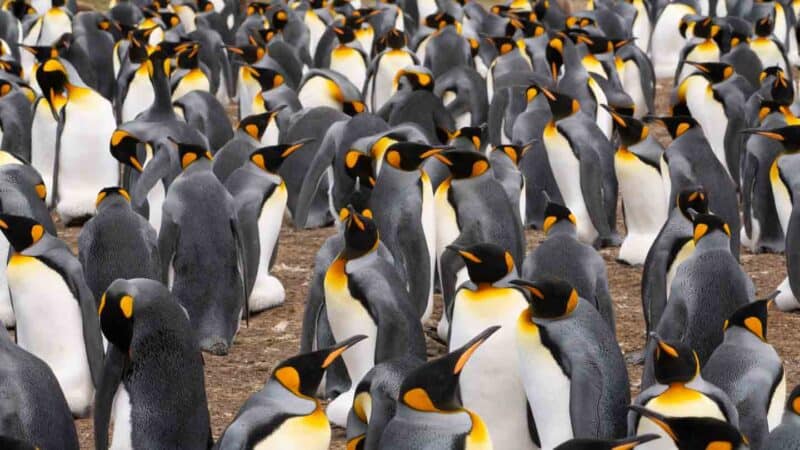
Set back from the beach by a few hundred feet is a cluster of black, white, yellow, and squawking. The King Penguins nest on the grassy hills away from the beach in a group known as a rookery. Even if you didn’t know where the colony was, you could just follow your ears. The King Penguins have a very nasally, trumping call, and with a few hundred birds – someone is always squawking.
On the day that we visited, there were four people at Volunteer Point. Besides talking to my new friend on the beach for a few minutes, the only other live beings I saw were penguins and sheep. In the afternoon, I had the whole rookery to myself and spent my time loading up my memory cards with shots where penguins covered the frame from one side to the other.
During this time of the year (Early December), it was too early for this year’s chicks to be hatched. So inside the rookery, it was mostly adults sitting on their eggs, waiting for them to hatch.
On the outskirts, young penguins born last year hung out in small groups. Some of the young ones had begun to molt, losing their brown baby down, and started to look more like the adults in their black and white waterproof plumage.
While others were stuck somewhere in the middle in that awkward phase of life between childhood and becoming an adult, which I am sure most of us can relate to. The penguins stuck in between were not the most attractive, but they soon became some of my favorites.
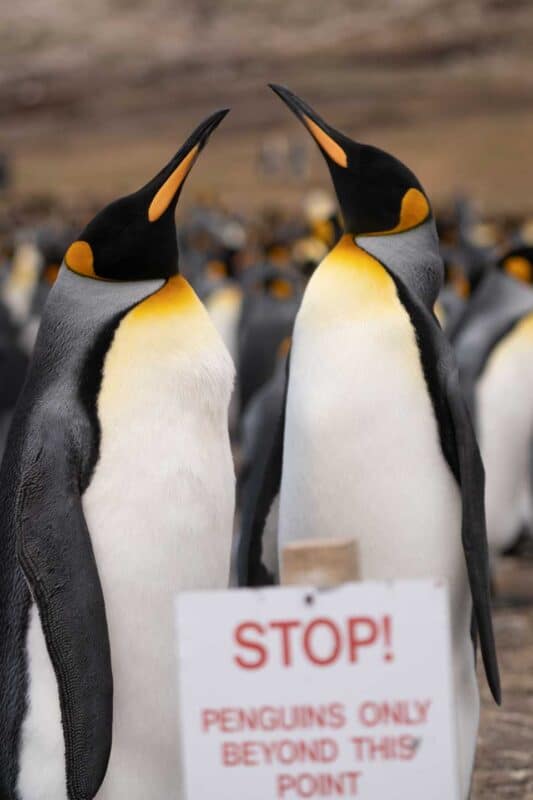
There were signs posted to protect the penguins, which we, of course, respected, but we were still ridiculously close to these beautiful wild penguins. However, the juvenile penguins didn’t want to stay on their side of the signs – they came right up to us to investigate. No matter how far back you stay, these fuzzy little penguins will come to check you out and even peck at your camera.
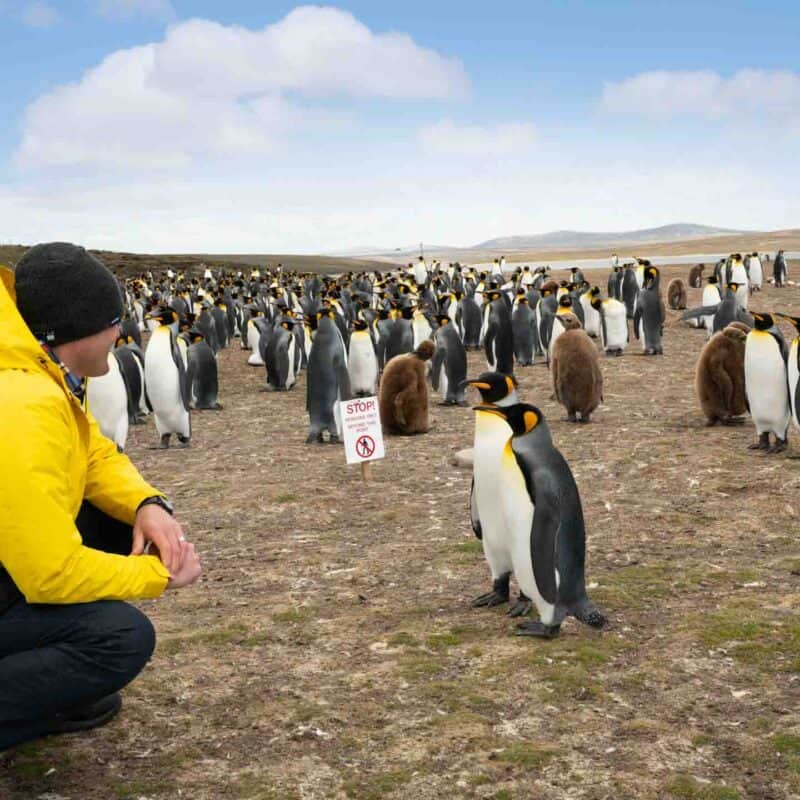
At one point, I took a break from photographing the main colony of penguins to watch a group of three curious penguins waddle around my camera and tripod. They were so interested in the camera I set out my GoPro and let them play with it.
You have to watch out though. Just because they are young doesn’t mean they are small. They are more than big enough to knock over a camera set on a tripod like they almost did mine.
It was tough to say goodbye to these amazing penguins, but the road in is the same road – and it’s not one you’d want to attempt in the dark. The day spent visiting Volunteer Point was one of the highlights of not just this trip to the Falklands but one of the highlights of this year of travel.
If you are looking for unique wildlife experiences, put the Falkland Islands on your list!
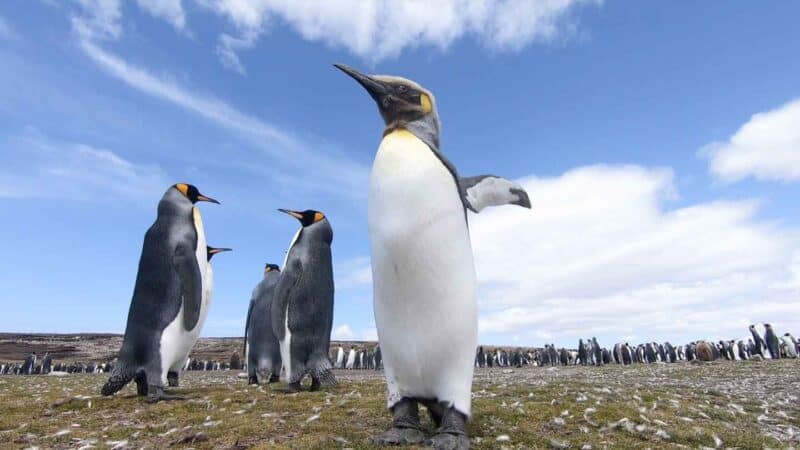
Volunteer Point FAQ
Q: How many King Penguins are at Volunteer Point? And how many King Penguins are there in the world?
A: There are around 1,000-1,500 breeding pairs living here at Volunteer Point. The total world population of King Penguins is around 1.7 million breeding pairs. They are currently not endangered and listed by IUCN as “Least Concerned”, meaning they are doing well.
Q: Where can you find King Penguins in the Falklands?
A: King Penguins are primarily found only at Volunteer Point in large numbers. Falklands Conservation reports 1,500 breeding pairs of king penguins on the islands, and they are found almost entirely here at Volunteer Point.
Q: How long do king penguins live?
A: The life expectancy of king penguins is around 20 years.
Q: How big are the king penguins?
A: King Penguins can grow up to 3.1 feet (.95 meters) tall and weigh up to almost 40 lbs (17kg)
Related Article: What To Wear In Antarctica – Clothing Packing List
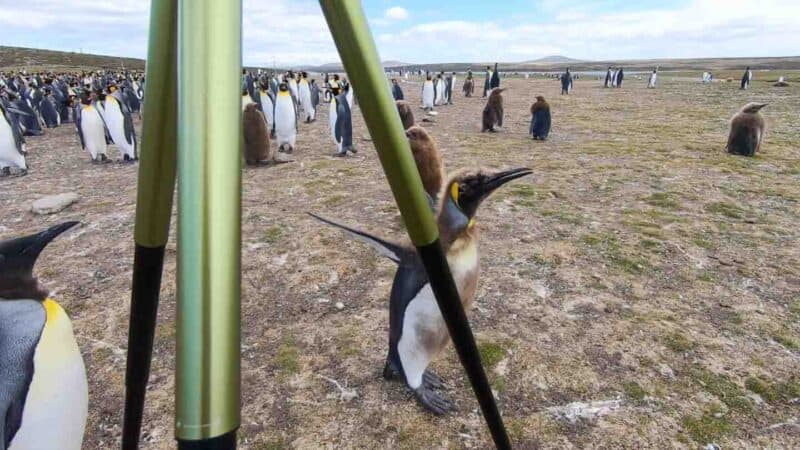
Tips for visiting Volunteer Point
Avoid the Crowds – If you can avoid visiting Volunteer Point on a day when a cruise ship is in port. If you happen to be on a cruise, you, of course, don’t have that option, but even with a few more people, it’s still an amazing place to visit.
Watch the Wind – If you are lucky enough to have a non-windy part of the day **stop whatever you are doing and head down to the beach**. The sand on the beach of Volunteer Point is very fine, and with the wind, it turns into a sandstorm down on the beach. Sand can be very damaging to camera equipment, so be sure to take advantage of any part of the day when you have calm winds. We’ve actually had sand damage to camera equipment before, but thankfully, our Safety Wing covered the repairs.
Protect your gear – Keep an eye on your tripods and camera gear around the King Penguin Rookery. The young penguins are super curious and they are big enough to knock over your gear.
Try to book a room – There are a few guest rooms for rent at the warden’s house for nature and photography lovers. Some truly magical photographs happen at sunrise and sunset here – and the only way to be here during those times is to stay right in Volunteer Point.
Don’t forget your insurance! You never know when you’ll need it. We suggest getting travel insurance with Safety Wing. Which coverage includes medical, trip interruption, lost luggage, and more. Often rates are as low as $12 a week.
Seasons at Volunteer Point – King Penguin Breeding Seasons
The King Penguins have a very long breeding cycle of about 14-16 months from laying the egg until the young penguins are ready for the sea. This means most breeding pairs will only have two chicks every three years.
You’ll find penguins at Volunteer Point year-round due to the long cycle, but many adults will leave during the winter months. Depending on the time of year you visit, you’ll see different stages of life at Volunteer Point. Below, we have listed out what you might find, but keep in mind things can vary from year to year slightly.
September – November: The adult penguins being to return to the colony, the penguins that did not have a chick in the previous year can return earlier in the season.
November to Mid-January: You should find adult penguins sitting in the rookery, incubating their eggs (55-day incubation period). Last year’s chicks will have begun to lose their brown baby down or pin feathers.
Mid-January to February: The chicks will begin to hatch, and you’ll get a chance to see the little penguins hanging out from underneath mom and dad’s feet while they are in the guarding phase.
March: The chicks are big enough to venture out a little way, and they cluster in groups on juveniles, all with their fluffy brown feathers.
April – August: By April, this year’s chicks will be nearing their full size, and they will stay on land while most Adults will go to sea for the winter.
Don’t forget to pin me for later!
